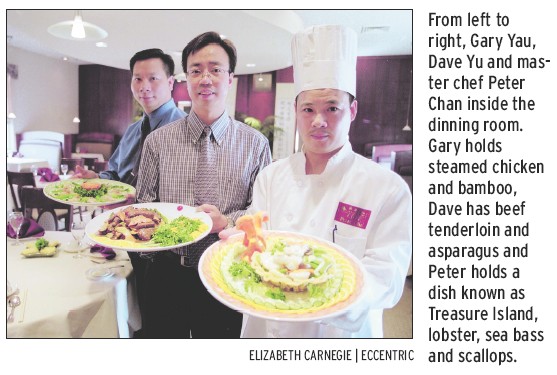Try authentic Cantonese cuisineBY ELEANOR HEALD
CORRESPONDENT
HONG HUA Where: 27925 Orchard Lake Road, Farmington Hills (248)489-2280. Open: 11a.m.-10:30p.m. Monday-Thursday, until midnight Friday and Saturday, noon to midnight Sunday. Food style: Authentic Cantonese Chinese cuisine with some Szechuan items. Prices: Appetizers and soups $3-9. Principal plates $13-17. Reservations: Recommended Asian cuisine continues as a taste trend across the U.S. Yet frequently, Cantonese Chinese takes a bottom rung on the preference ladder. That is, unless you've experienced Hong Hua in Farmington Hills, where the food and service work at convincing you that authentic Cantonese Chinese cooking is arguably superior to all other Chinese regional cuisines. Confucianism and Taoism, which influenced the course of Chinese history, also developed the culinary arts. Confucianism focused on taste, texture and food appearance. It also placed emphasis on the enjoyment of life, to the extent that food and friends are inseparable. Taoists were concerned about the life-giving attributes and nutritional value of various foods. Cantonese cooking embraces both philosophies. It was the first Chinese regional cuisine to hit American shores when Chinese immigrants from Canton came to build the U.S. railways in the 1800s. They had difficulty transplanting traditional cooking for a number of reasons. Immigrants were principally men, from a Chinese culture where women did all the cooking. Unfamiliar ingredients caused unsuccessful adaptations. To compensate for a lack of traditional flavors, overcompensation in the use of sugar and soy sauce became common. American Cantonese was born! LET'S BE GRATEFUL Hong Hua, translating as "grateful," has owners that are bent on presenting traditional Cantonese dishes to Americans. Getting their start in Montreal, partners Danny Yu, Gary Yan, Shetwei Seto and Chef Peter Chan have been together for 20 years. Chan is the brilliance behind the traditional Cantonese dishes. His partners are masters at pleasing customers and running a business that showcases Chan's cooking. At 17 years old, Chan began cooking in Hong Kong restaurants and eventually found his way to the famed Far Eastern, a members only dining club. Hong Hua opened two years ago in a free-standing building, formerly occupied by a Bill Knapp's. The owners created an atmosphere that subtly announces an oriental eatery with lots of understated American casual elegance from white tablecloths to warm cherry wood and soft-toned fabrics and carpeting. The menu is extensive, so Danny Yu offered navigation tips. His first suggestion was to begin with a soup, either Premium Wonton in Soup, which has both the fragrance and taste of homemade chicken broth, or Shredded Duck and Mushrooms in Thick Soup. Chinese black mushrooms and a housemade duck stock create the authenticity. FROM APPS TO MAINS A Deep-fried Stuffed Crab Claw or Roasted Spareribs were Yu's appetizer proposals. The succulent spareribs are not steamed first, as is frequently the case. They are slow cooked while being basted with Chef Chan's special sauce. At this point in the meal, I'd be viewing a whole Peking Duck, to be carved tableside, arriving to my table of four (a little Confucianism!). A bargain at $32, it serves four in two separate courses: Crispy skin with pancakes and green onions; and shredded duck meat with Chinese vegetables and steamed rice. Peking Duck requires ordering a minimum of 24 hours in advance. Seafood dishes are the number one choices of regulars at Hong Hua. Many are prepared with grouper "because," Yu said, "it has good texture. We buy it fresh; never frozen and we do not freeze it once it is delivered from Florida." He suggested that the best preparation was Fried Fillet of Grouper and Vegetables in a spicy X.O. sauce, another of Chef Chan's culinary secrets. Pork and Beef lovers should consider Stir-fried Beef Tenderloin or Mongolian Style Beef. Among selections labeled "Special Suggestions," Yu singled out Seafood with Macadamia Nuts, Stir-fried Spicy Boneless Chicken with pineapple and lychee served in a crispy taro nest, Stir-fried Shrimp and Chicken in Phoenix Nest and Shrimp and Broccoli topped with Cream of Crab Sauce. "The basic difference between Szechuan and Cantonese," Yu said, "is that Szechaun dishes taste stronger because of the spices. Cantonese is lighter and, I believe, healthier. With traditionally-made Cantonese dishes, you get to taste the purity of top-quality ingredients that are not masked by sweet, sour or heavy spices." A new wine list, with some savvy matches to Cantonese dishes is available. It may not be the only new element for long. Yu is now in Hong Kong for a month to visit top restaurants and gain a wealth of new ideas. In Hong Kong, appreciation and preparation of Cantonese food has been developed to the highest level. Some cultures regard food preparation as a craft, but the Chinese consider cooking an art form. That's what it is at Hong Hua. Eleanor Heald is a Troy resident who writes about dining, food, wine and spirits for the Observer & Eccentric Newspapers. To leave her a voice mail message, dial (734) 953-2047 on a touch-tone phone, mailbox 1864#. |
